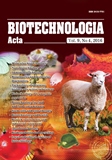ISSN 2410-7751 (Print)
ISSN 2410-776X (Online)

"Biotechnologia Acta" V. 9, No 4, 2016
https://doi.org/10.15407/biotech9.04.035
Р. 35-41 , Bibliography 10, English
Universal Decimal Classification: 616.097.578.828.519.874.2
THE SHELF LIFE PREDICTING OF IMMUNOENZYME COMBINED TEST-SYSTEMS FOR HIV1/2 DIAGNOSTICS
1PJSC «SPC» Diaproph-Med», Kyiv
2 Zabolotny Institute of Microbiology and Virology, Kyiv
The aim of the research was to determine the shelf life of the ELISA test kit DIA-HIVAg/Ab (PJSC "SPC" Diaproph-Med") intended for the determination of antibodies to HIV1/2 and p24 HIV1 antigen using accelerated storage model at elevated temperatures.
It is established that the thermal inactivation process is subject to a first-order kinetic law. The dependence of the rate constants of inactivation (lnK) on temperature (1 / T) is described by the Arrhenius equation at 95% probability level (F-test). Calculated on the basis of this model, the activation energy (ΔEa) equals 23.27 kcal • mol-1. It is established that the projected shelf life of the test kit was 2 years and 1 month when stored at 4 °C in terms of reduction of its diagnostic activity by 10%.
Isothermal method of accelerated storage based on the Arrhenius model can significantly save time by determining the expiration date of the test kit as early as at the stages of its development or modification. The obtained data can be used for confirmation of the diagnostic kit stability studies, in terms of long-term storage, correction recommended conditions, and for determination of test kit capability of withstanding exposure to adverse environmental factors, which may occur during transportation and storage.
Key words: accelerated storage method, the Arrhenius equation, immune enzyme analysis, HIV diagnosis, combined test kit.
© Palladin Institute of Biochemistry of the National Academy of Sciences of Ukraine, 2016
References
1. The HIV infection in Ukraine. Іnformacijnij bjuleten. Kyiv: MOZ Ukrainy. 2016, N 46, Р. 7–14. (In Ukrainian).
2. Trohimchuk T. Yu., Serdyuk V. G., Ganova L. A., GorlovYu. I., Michalap S. V., Spivak N. Ya. Study of diagnostic characteristics enzyme immunoassay kit hypersensitivity to HIV detection. Biotechnol. аcta. 2014, 7 (3), 88–94. (In Russian).
3. EN 23640.2015. In vitro diagnostic medical devices requirements. 2015, P. 10.
4. GOST R ISO 23640-2015. Medical devices for the diagnostic in vitro. Assessment of the reagent stability for the diagnostic in vitro. National standard of the russian federation. Products for medical diagnostic in vitro. Moskwa: Standartinform. 2015, 14 p. (In Russian).
5. Landau L. D., Ahiezer A. I., Lifshic E. M. The course of general physics. Mechanics and Molecular Physics. MGU. 1962, 405 p. (In Russian).
6. Agrahari V., Putty S., Mathes C., Murowchick J., Bi-Botti C. Evaluation of degradation kinetics and physicochemical stability of tenofovir. Drug Test Anal. 2015, 7 (3), 207–213. https://doi.org/10.1002/dta.1656
7. Lapach S. N., Chubenko A. V., Babich P. N. Statistical methods in biomedical research using Excel. Kyiv: Morion. 2001, 407 p. (In Russian).
8. Duncan M., Zaretsky Ir. Predict stability using data collected at higher temperatures. Pharmaceutical Formulation and Quality. 2011, V. 13, P. 1–7.
9. Kommanaboyina B., Rhodes C. Trends in stability Testing, with Emphasis on Stability During Distribution and Storage. Drug Dev. Ind. Pharm. 1999, V. 25, P. 857–867. https://doi.org/10.1081/DDC-100102246
10. Bajaj S., Singla D., Sakhuja N. Stability Testing of Pharmaceutical Products. J. Appl. Pharmaceut. Scie. 2012, 2 (3), 129–138.

